




Your support is critical to our success.
= Parodia tilcarensis var. gigantea (Krainz) Backeb.
Cactaceae (Backeberg) 3: 1603. 1959 Backeb.
Accepted Scientific Name: Parodia stuemeri var. tilcarensis (Werderm. & Backeb.) Borg

Origin and Habitat: Argentina (Salta)
Synonyms:
- Parodia tilcarensis var. gigantea (Krainz) Backeb.
- Microspermia gigantea (Krainz) Frič ex Kreuz.
- Parodia gigantea Frič ex Krainz
Parodia stuemeri (Werderm.) Backeb.
Cactus (Sint-Amandsberg) iv. 57 (1934); et in Kakteenfreund, iv. 50 (1935);
Synonymy: 6
- Parodia stuemeri (Werderm.) Backeb.
- Bolivicactus stuemeri (Werderm.) Doweld
- Echinocactus stuemeri Werderm.
- Parodia gutekunstiana Backeb.
- Parodia rubricentra Backeb. in Backeb. & F.M.Knuth
- Parodia rubrispina U.Köhler
Parodia stuemeri var. tilcarensis (Werderm. & Backeb.) Borg
Synonymy: 16
- Parodia stuemeri var. tilcarensis (Werderm. & Backeb.) Borg
- Bolivicactus tilcarensis (Werderm. & Backeb.) Doweld
- Echinocactus stuemeri var. tilcarensis Werderm. & Backeb.
- Parodia tilcarensis (Werderm. & Backeb.) Backeb.
- Parodia carminata Backeb. in Backeb. & F.M.Knuth
- Parodia friciana F.H.Brandt
- Parodia gokrauseana Heinrich
- Parodia jujuyana Frič ex Subik, Pazout & Valnicek
- Parodia pseudostuemeri Backeb.
- Parodia schuetziana Jajó
- Parodia scoparia F.Ritter
- Parodia setosa Backeb.
- Parodia tilcarensis var. gigantea (Krainz) Backeb.
- Microspermia gigantea (Krainz) Frič ex Kreuz.
- Parodia gigantea Frič ex Krainz
- Parodia tumbayana Weskamp
Description: Parodia tilcarensisSN|5863]]SN|860]] var gigantea differs from the standard Parodia tilcarensisSN|860]]SN|860]] for the more elongated or cylindrical stem up to 30 cm tall with stouter spines and red flowers. It one of the several species of the very variable Parodia stuemeriSN|860]]SN|5863]] which form a complex of related taxon. It is still unclear whether this variable complex is one or several species. There is so much variation that most authors choose to lump them together until further studies are done.
Subspecies, varieties, forms and cultivars of plants belonging to the Parodia stuemeri group
 Parodia stuemeri (Werderm.) Backeb.: up to 20 cm tall and 15 cm Ø. Spines dusky-yellow to nearly black. Flowers yellowish, orange or reddish. Distribution: Argentina Northwest (Jujuy, Salta).
Parodia stuemeri (Werderm.) Backeb.: up to 20 cm tall and 15 cm Ø. Spines dusky-yellow to nearly black. Flowers yellowish, orange or reddish. Distribution: Argentina Northwest (Jujuy, Salta). Parodia stuemeri var. tilcarensis (Werderm. & Backeb.) Borg: Distribution: Argentina Northwest (Jujuy, Salta).
Parodia stuemeri var. tilcarensis (Werderm. & Backeb.) Borg: Distribution: Argentina Northwest (Jujuy, Salta). Parodia tilcarensis var. gigantea (Krainz) Backeb.: Stem much elongated or cylindrical up to 30 cm tall and 5-6 cm in diameter. Distribution Argentina (Salta)
Parodia tilcarensis var. gigantea (Krainz) Backeb.: Stem much elongated or cylindrical up to 30 cm tall and 5-6 cm in diameter. Distribution Argentina (Salta)
Bibliography: It is relatively easy to grow on its own roots.
Soil: Grow it in an open sandy-gritty cactus compost.
Pots: It needs a relatively shallow pot to accommodate its fibrous roots and provide a very good drainage. It may stay in the same pot for many years.
Watering: Water in moderation, it prefer a completely dry place during winter. Mature individuals easily rot and die especially after planting so be extremely cautious with watering. Keep dry in winter or when night temperatures remain below 10° C. Water it less than average if in bigger pots.
Special need: Provide very good ventilation. Nearly all problems occur as a result of overwatering and poor ventilation, especially when weather conditions are dull and cool or very humid.
Fertilization: Feed them once during the growing season with a fertilizer specifically formulated for cactus and succulents (high potash fertilizer with a dilute low nitrogen), including all micro nutrients and trace elements diluted to ½ the strength recommended on the label. They thrive in poor soils and need a limited supplies of fertilizer to avoid the plants developing excess vegetation, which is easily attacked by fungal diseases.
Exposure: It will do its best with lots of sun and become stressed with inadequate light which could result in poor growth and unnatural shape.
Hardiness: It likes warmth (recommended minimum winter temperature 5° C) however plants kept perfectly dry can can survive low temperatures, approx. -5°, but for safe cultivation it is best to avoid freezing temperatures.
Use: This is a good pot plant suited for a non heated green house. It can be also cultivated outdoors in raised beds, terraces if sheltered from winter rain. This cactus continues to be, a particular prize among collectors
Pests & diseases: These cacti may be attractive to a variety of insects, but plants in good condition should be nearly pest-free, particularly if they are grown in a mineral potting-mix, with good exposure and ventilation. Nonetheless, there are several pests to watch for:
- Red spiders: Red spiders may be effectively rubbed up by misting the plants from above.
- Mealy bugs: Mealy bugs occasionally they develop aerial into the new leaves and flowers with disfiguring results, but the worst types develop underground on the roots and are invisible except by their effects.
- Rot: Rot is only a minor problem if the plants are watered and “aired” correctly. If they are not, fungicides won't help all that much.
Propagation: Seeds. The seeds can be sown in pots of fine, well-drained sandy soil, any time during the spring when temperatures are warm. Cover the seeds with a fine layer of grit and water from below with a fungicide to prevent damping off. For the 1-2 weeks cover the pots with a sheet of glass/clear perspex to keep the humidity levels high. Remove the glass and replace it with light shade-cloth and mist once or twice a day for the next two weeks after which most seeds should have germinated. From then on mistings can be reduced to every second and then every third day as the little plants grow.
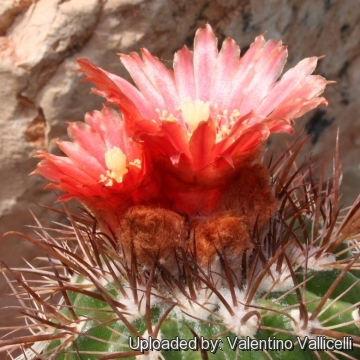
Parodia gigantea (Parodia tilcarensis var. gigantea) Photo by: Valentino Vallicelli
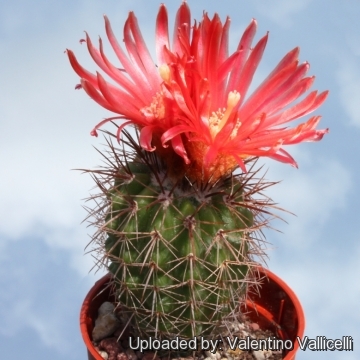
Parodia gigantea (Parodia tilcarensis var. gigantea) Photo by: Valentino Vallicelli
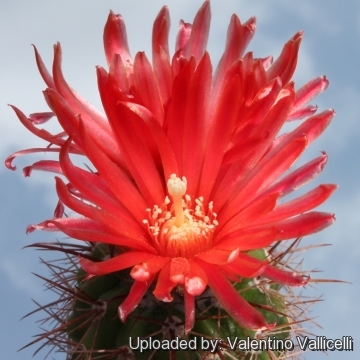
Parodia gigantea (Parodia tilcarensis var. gigantea) Photo by: Valentino Vallicelli
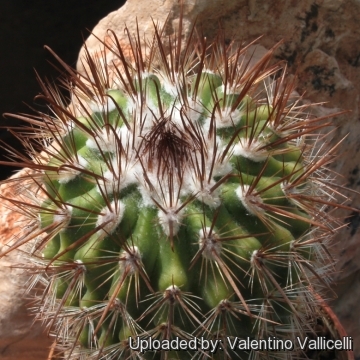
Parodia gigantea (Parodia tilcarensis var. gigantea) Photo by: Valentino Vallicelli
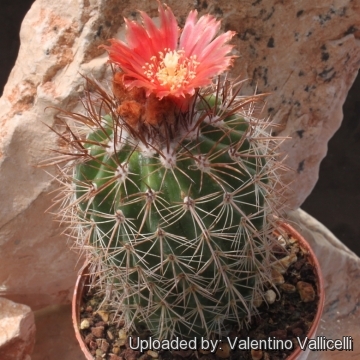
Parodia gigantea (Parodia tilcarensis var. gigantea) Photo by: Valentino Vallicelli
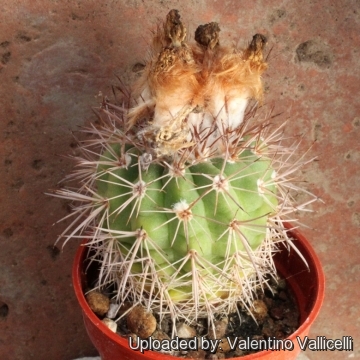
Parodia gigantea (Parodia tilcarensis var. gigantea) Photo by: Valentino Vallicelli
Cultivation and Propagation: It is relatively easy to grow on its own roots.
Soil: Grow it in an open sandy-gritty cactus compost.
Pots: It needs a relatively shallow pot to accommodate its fibrous roots and provide a very good drainage. It may stay in the same pot for many years.
Watering: Water in moderation, it prefer a completely dry place during winter. Mature individuals easily rot and die especially after planting so be extremely cautious with watering. Keep dry in winter or when night temperatures remain below 10° C. Water it less than average if in bigger pots.
Special need: Provide very good ventilation. Nearly all problems occur as a result of overwatering and poor ventilation, especially when weather conditions are dull and cool or very humid.
Fertilization: Feed them once during the growing season with a fertilizer specifically formulated for cactus and succulents (high potash fertilizer with a dilute low nitrogen), including all micro nutrients and trace elements diluted to ½ the strength recommended on the label. They thrive in poor soils and need a limited supplies of fertilizer to avoid the plants developing excess vegetation, which is easily attacked by fungal diseases.
Exposure: It will do its best with lots of sun and become stressed with inadequate light which could result in poor growth and unnatural shape.
Hardiness: It likes warmth (recommended minimum winter temperature 5° C) however plants kept perfectly dry can can survive low temperatures, approx. -5°, but for safe cultivation it is best to avoid freezing temperatures.
Use: This is a good pot plant suited for a non heated green house. It can be also cultivated outdoors in raised beds, terraces if sheltered from winter rain. This cactus continues to be, a particular prize among collectors
Pests & diseases: These cacti may be attractive to a variety of insects, but plants in good condition should be nearly pest-free, particularly if they are grown in a mineral potting-mix, with good exposure and ventilation. Nonetheless, there are several pests to watch for:
- Red spiders: Red spiders may be effectively rubbed up by misting the plants from above.
- Mealy bugs: Mealy bugs occasionally they develop aerial into the new leaves and flowers with disfiguring results, but the worst types develop underground on the roots and are invisible except by their effects.
- Rot: Rot is only a minor problem if the plants are watered and “aired” correctly. If they are not, fungicides won't help all that much.
Propagation: Seeds. The seeds can be sown in pots of fine, well-drained sandy soil, any time during the spring when temperatures are warm. Cover the seeds with a fine layer of grit and water from below with a fungicide to prevent damping off. For the 1-2 weeks cover the pots with a sheet of glass/clear perspex to keep the humidity levels high. Remove the glass and replace it with light shade-cloth and mist once or twice a day for the next two weeks after which most seeds should have germinated. From then on mistings can be reduced to every second and then every third day as the little plants grow.
| Your Actions | |
|---|---|
| Back to Parodia index | |
| Back to Cactaceae index | |
 |
Back to Cacti Encyclopedia index |
Privacy stantement - Terms and conditions - How to cite - About us - Feedback - Donate




